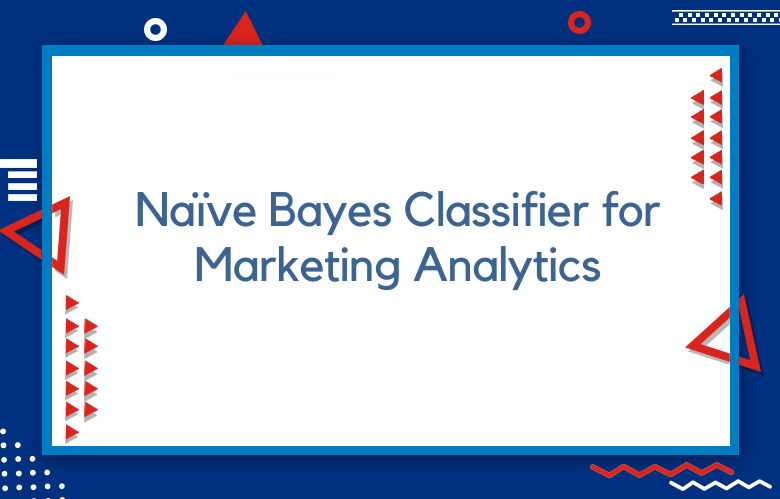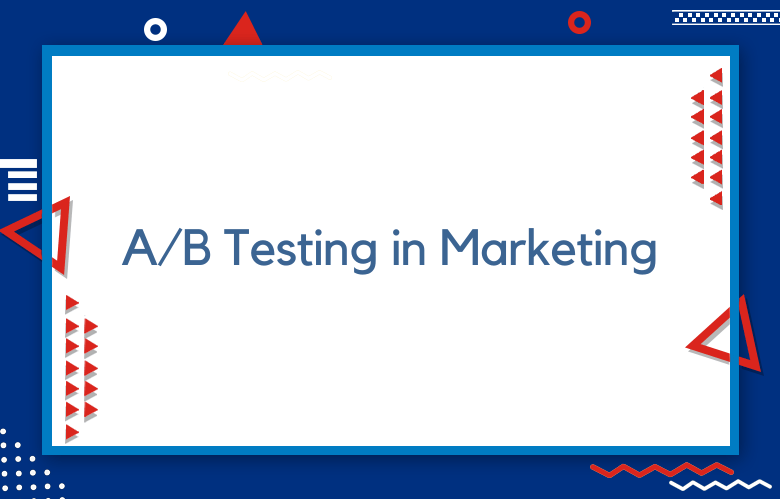How to use a Naïve Bayes Classifier for Marketing Analytics

The Naive Bayes classifier is a powerful tool that helps in marketing analytics. This tool can help you predict the likelihood of an event’s occurrence based on past data. For example, you could use a Naive Bayes classifier to predict the probability of a customer purchasing a product based on age, gender, and location.
The Naive Bayes classifier can predict whether a customer will purchase a product.
The Naive Bayes classifier assumes that all variables are independent of each other.
This assumption is called the “naive” assumption because it is usually untrue.
However, this assumption makes the math more accessible and the predictions more accurate than if we did not make this assumption.
What is Naïve Bayes Classifier?
Naïve Bayes is a well-known machine learning algorithm used for classification tasks.
The Naive Bayes algorithm assumes that all features are independent, simplifying the calculation of probabilities. The Naive Bayes classifier is a powerful tool for handling categorical and continuous data.
It has been shown to perform well on various data sets, including text classification and medical diagnosis. Despite its simplicity, the Naive Bayes classifier can effectively solve complex problems.
Naive Bayes classifiers assume that all features are independent, simplifying the calculation of the probability of an event occurring.
Despite this simplification, Naive Bayes classifiers are effective in various tasks, including text classification and spam filtering.
How to use a Naïve Bayes Classifier for Marketing Analytics
Naïve Bayes Classifier is a supervised learning algorithm that helps with marketing analytics.
For example, it can predict whether a customer will buy a product based on their past behavior.
Naïve Bayes Classifier is trained on data labeled with the desired output.
For example, if you like to predict whether a customer will buy a product, you would label the data with “1” for customers who purchased the product and “0” for customers who did not.
The Naïve Bayes Classifier then uses this training data to make predictions.
Naïve Bayes Classifier is a powerful tool that helps in marketing analytics.
Naïve Bayes Classifier is trained on data labeled with the desired output. For example, if you like to predict whether a customer will buy a product, you would mark the data with “1” for customers who purchased the product and “0” for customers who did not. The Naïve Bayes Classifier then uses this training data to make predictions.
Naive Bayes classifiers are a type of linear classifier, and they are popular because they are easy to build and require little training data.
Naive Bayes classifiers are used in various applications, including marketing analytics.
Marketing analysts can use Naive Bayes classifiers to predict whether a customer will respond to a marketing campaign. To do this, the analyst first collects data about past marketing campaigns, including information about which customers responded and which did not. This data is then used to train the Naive Bayes classifier.
Once the classifier has been trained, it can predict the likelihood that a customer will respond to a new marketing campaign.
Naive Bayes classifiers are imperfect but can accommodate marketing analysts trying to predict customer behavior.
Using a Naive Bayes classifier, analysts can create more targeted marketing campaigns and make more informed decisions about where to allocate their marketing budgets.
Ways to use Naïve Bayes Classifier for Marketing Analytics
Segmenting customers by purchase history
Naïve Bayes Classifier can be used to segment customers by their purchase history. This information can then be used to target marketing campaigns specifically for those customers who are most likely to purchase.
Identifying potential new customers
Naïve Bayes Classifier identifies potential new customers. By analyzing customer data, businesses can identify those most likely to become customers and target their marketing efforts accordingly.
Determining the most effective marketing strategies
Naïve Bayes Classifier can also determine the most effective marketing strategies. By analyzing customer data, businesses can identify which marketing strategies will most likely result in a sale. This information can then be used to optimize marketing campaigns for maximum effectiveness.
Measuring the effectiveness of marketing campaigns
Naïve Bayes Classifier helps to measure the effectiveness of marketing campaigns. Businesses can identify which campaigns successfully convert leads into customers by analyzing customer data. This information can then be used to improve future marketing efforts.
Predicting customer behavior
Naïve Bayes Classifier can also be used to predict customer behavior. By analyzing customer data, businesses can identify trends in customer behavior and use this information to anticipate future needs and wants. This information can then be used to tailor marketing campaigns specifically for those customers.
Improving customer service
Naïve Bayes Classifier can also be used to improve customer service. Businesses can identify areas where customer service is lacking by analyzing customer data and taking steps to improve it. This improved customer service will lead to increased customer satisfaction and loyalty.
Reducing churn rate
Naïve Bayes Classifier can also be used to reduce churn rate. By analyzing customer data, businesses can identify customers at risk of leaving and take steps to retain them. This includes offering discounts, providing better customer service, or tailoring marketing campaigns specifically for those customers.
Increasing sales conversion rate
Naïve Bayes Classifier can also be used to increase sales conversion rate. By analyzing customer data, businesses can identify prospects most likely to make a purchase and target their sales efforts accordingly.
Identifying cross-selling opportunities
Naïve Bayes Classifier can also be used to identify cross-selling opportunities. By analyzing customer data, you can determine which products are often purchased together and offer discounts or promotions accordingly.
Predicting customer churn
Another way to use Naïve Bayes Classifier is to predict customer churn. This information can be used to develop strategies for retaining customers and reducing churn rates.
Estimating the likelihood of a purchase
Naïve Bayes Classifier can also estimate the likelihood of a purchase being made. This information helps to target marketing efforts at specific customers or groups of customers.
Determining the most effective marketing channels
You can also use Naïve Bayes Classifier to define the most effective marketing channels for your business. This information can help you plan your marketing budget more effectively and improve your ROI.
Developing targeted marketing campaigns
Naïve Bayes Classifier can also be used to develop targeted marketing campaigns. By segmenting your customers and understanding their purchasing habits, you can create campaigns that are more likely to resonate with them and result in a sale.
Improving customer segmentation
Another way to use Naïve Bayes Classifier is to improve customer segmentation. This information can help you create targeted marketing campaigns and improve customer retention rates.
Analyzing customer feedback
Naïve Bayes Classifier can also be used to analyze customer feedback. This information can help you understand what customers like and don’t like about your brand.
Identifying at-risk customers
Naïve Bayes Classifier can also be used to identify at-risk customers. This information can help you develop strategies for retaining these customers and reducing churn rates.
Segmenting customers
Naive Bayes can be used to segment customers based on their likelihood of purchasing a product or service. This information can target marketing efforts toward those more likely to be interested in what is offered.
Identifying cross-sell and upsell opportunities
Naive Bayes can also be used to identify cross-sell and upsell opportunities. For example, suppose a customer buys product A. In that case, they may be more likely to buy product B. By targeting customers who have already purchased product A with marketing for product B, businesses can increase sales of both products.
Predicting customer churn
Naive Bayes can be used to predict customer churn, which is when a customer stops doing business with a company. This information can be used to take steps to prevent customers from leaving, such as offering discounts or improving customer service.
Evaluating marketing campaigns
Naive Bayes can be used to evaluate the effectiveness of marketing campaigns. This information can help businesses determine which campaigns are working and which are not so that they can make changes accordingly.
Determining the most effective channels for marketing
Naive Bayes can also be used to determine the most effective marketing channels. This information can help businesses allocate their marketing budgets more effectively and reach their target audiences more efficiently.
Generating targeted leads
Naive Bayes can generate targeted leads for sales and marketing teams. This information can help businesses focus their efforts on individuals more interested in what they have to offer.
Improving customer segmentation
Naive Bayes can also be used to improve customer segmentation. This information can help businesses create more accurate segments and effectively target their marketing efforts.
Creating personalized recommendations
Naive Bayes can be used to create personalized recommendations for customers.
This information can help businesses provide each customer with tailored recommendations that are more likely to result in a sale.
How does Naïve Bayes Classifier Work?
The Naive Bayes classifier works by using probability to calculate the likelihood of an event occurring. To do this, the classifier first looks at past data to identify patterns.
Once it has identified patterns, it can then use them to predict the likelihood of an event occurring in the future.
For example, suppose the classifier sees that customers aged 18-24 who live in New York are more likely to purchase a product than customers aged 25-34 who live in California. In that case, it will use this information to predict the likelihood of a customer purchasing a product.
Practical Uses for Marketing Analytics
There are many practical uses for the Naive Bayes classifier in marketing analytics. As mentioned above, you can use this tool to predict the likelihood of a customer purchasing a product.
However, you can also use it to segment your customers or target your marketing campaigns.
For example, let’s say you’ve segmented your customers into two groups: those likely to purchase your product and those not expected to.
You could then use this information to target your marketing campaigns. You could send marketing material to the group likely to purchase your product to increase sales.
You could send educational material to the group that is not likely to purchase your product to increase awareness and understanding.
There are two steps in using a Naive Bayes classifier for marketing analytics.
The first step is to gather data about your customers. The second step is to use the Bayesian theorem to calculate the probabilities of each variable.
The data you gather about your customers should include their age, gender, income, location, and whether they have purchased your product before.
You can gather this data by surveying your customers or by looking at your already existing customer data.
Once you have this data, you must input it into a spreadsheet.
The second step is to use the Bayesian theorem to calculate the probabilities of each variable. The math for this step is relatively simple.
First, you need to calculate the probability of each variable (age, gender, income, location), given that the customer has purchased your product (P(A|B)). This probability is called conditional probability.
To calculate, you must determine how many people in your customer data have each variable (age, gender, income, location) and how many people have purchased your product.
For example, if 100 people in your customer data are female and 60 of them have purchased your product, then the conditional probability P(female|purchased)=60%.
You can then use these conditional probabilities to calculate the probability that a customer will purchase your product given their age, gender, income, and location (P(purchased|A&B&C&D)). This probability is called the posterior probability.
The final step is to compare the posterior probabilities for each combination of variables (age, gender, income, location) and choose the mix with the highest chance. This combination of variables is most likely to result in a purchase from your customer.
Conclusion
This tool can segment your customers or target your marketing campaigns more effectively.
Marketing analytics is critical to success in the modern marketing landscape.
Analyzing customer behavior effectively can give you a significant edge over your competition.
The Naïve Bayes Classifier is a powerful tool to help you do that.
By understanding how it works and how to apply it, you can start using it right away to improve your marketing efforts.
Contact us today if you need help getting started or need guidance from an expert. Our expert team would be happy to plan your specific needs and see how we can help you take your marketing analytics game to the next level.
Call: +91 9848321284
Email: [email protected]



